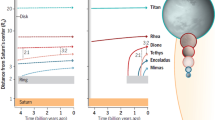IN 1979, the simultaneous revelation of Europa’s weird surface and the tidal source of its heat transformed the icy moon into a leading contender for extraterrestrial life. In the 1980s, Ray Reynolds, part of the original team that had predicated the tidal heating, led much of the research on the implications of these discoveries for the possibility of life. With his co-workers at NASA’s Ames Research Center, he recognized the likelihood of a global ocean and estimated that the ice crust must be less than 10 km thick. Long before I got directly involved, he and his group had already interpreted the visible lines as cracks linking the ocean to the surface, and they had already written in detail about how that setting might support life.
That work was exciting stuff. Randy Tufts by that time had spent many years in social service work, and his stewardship of the Cave was coming to completion—largely through his efforts, it became a state park. At age forty, he was looking for a direction for the next phase of his life. Then he read about Europa’s ocean and grasped its implications for life. He had an undergraduate degree in geology, he knew that the Galileo spacecraft was on its way to Jupiter, and he realized that the new images could tell whether Europa really was a contender for life. He returned to the University of Arizona, this time as a graduate student, and joined my research group as the spacecraft’s data began to arrive.
The consensus of the planetary-science community was more conservative. In general, the very existence of the ocean, let alone the idea that the ice might be thin enough to create a habitable setting, was still considered unresolved. Ray Reynolds and his collaborators were highly respected, but their work on Europan life was generally considered to be intelligent speculation. So, by 1998 when a different authorized conclusion began to emerge from the Galileo imaging team—an ice shell so thick that any ocean must be isolated—the vision of Reynolds et al. seemed to be irrelvant.
Access this chapter
Tax calculation will be finalised at checkout
Purchases are for personal use only
Preview
Unable to display preview. Download preview PDF.
Similar content being viewed by others
Rights and permissions
Copyright information
© 2008 Praxis Publishing, Ltd
About this chapter
Cite this chapter
(2008). The Biosphere. In: Unmasking Europa. Springer, Boston, MA. https://doi.org/10.1007/978-0-387-09676-6_17
Download citation
DOI: https://doi.org/10.1007/978-0-387-09676-6_17
Publisher Name: Springer, Boston, MA
Print ISBN: 978-0-387-47936-1
Online ISBN: 978-0-387-09676-6
eBook Packages: Physics and AstronomyPhysics and Astronomy (R0)



